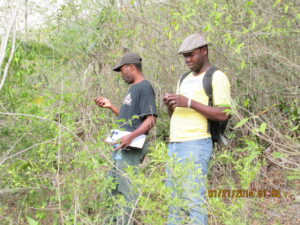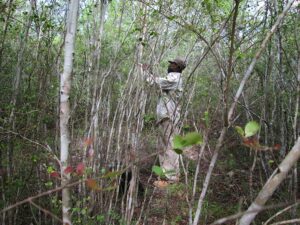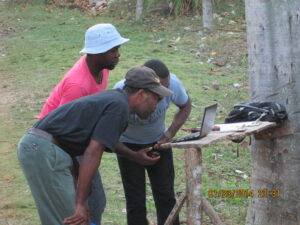A Case Study of Dissertation Research Collaboration in Rural Haiti – Part 2 of 4
 In the previous installment of this 4-Part series on research collaboration in rural Haiti, Florida’s Andrew Tarter discussed the benefits to social scientists of collaborating with research counterparts at Faculté d’Ethnologie (Department of Ethnology) at L’Université d’État d’Haïti (State University of Haiti). Here he continues with a list of steps that provide a blueprint toward successful collaboration.
In the previous installment of this 4-Part series on research collaboration in rural Haiti, Florida’s Andrew Tarter discussed the benefits to social scientists of collaborating with research counterparts at Faculté d’Ethnologie (Department of Ethnology) at L’Université d’État d’Haïti (State University of Haiti). Here he continues with a list of steps that provide a blueprint toward successful collaboration.
3. Connect with a wide range of potential collaborators.
Connecting with students and having discussions with faculty members from Faculté d’Ethnologie provides several advantages, even if you don’t have expendable funding to employ students (see ‘Why Collaborate?’ in the previous post). Just be certain to be explicit that you’re conducting interviews to acquire data or for purposes of collaboration, and not for a paid position. Connecting with multiple people follows classical sampling logic: you increase variability, and by extension increase potential fields of collaboration.
I conducted my interviews entirely in Kreyòl (Haitian Creole), though many of the students demonstrated strong command of both French and English during the interview process. While some students had clearly read the research synopsis I had circulated, many had not; a substantial portion of the interviewing period was spent explaining the research. Be prepared to give multiple explanations of your proposed research.
The simple fact that the paid research collaborator positions I was recruiting for were to last 9 months was a major deterrent for some students. To top it off, the research was in a remote part of the southern peninsula, far from capital city. The extreme physical challenges of the research—walking many miles into remote woodlots under an unrelenting Haitian sun—was another deterrent for other students. One student declined during the interview, stating that these woodlots were home to any number of wild animals, including dangerous snakes. More than one student mentioned that the daily stipend was well below what they might expect to receive as a per diem from USAID, or any number of NGOs conducting research in the country. I agreed. But I also explained that researchers would have their room-and-board covered, and with very little to spend money on in the countryside they would have an opportunity to reliably save the lion’s share of their stipend. Furthermore, each research collaborator would receive a field laptop, chosen for its 12-hour battery capacity—a major advantage in a country with sporadic and unreliable electricity. The laptop would be theirs to keep at the end of the research period.
By and by the 20 CVs were narrowed down to approximately five candidates, three of which accepted positions. All three students were memoran—the equivalent to undergraduates who have completed their coursework, had their memoir (thesis) topic approved, but have not yet written nor defended their memoir.

4. Establish a research contract
After the three students successfully relocated to the research site, we got to work. One of the first items of order we tackled as a team was the creation of research contracts. I submitted a blueprint contract that reflected my concerns, objectives, priorities and stipulations as the principal investigator; the students in turn added stipulations of their own and some wording corrections to make the contract clearer. In the end we co-created a concise 1-page contract that outlined the perimeters and parameters of the research to be conducted and the expectations of all parties involved. I highly recommend that researchers entering into collaborative endeavors with other scholars conduct this exercise. It ensures a clear understanding of the research to all parties involved, provides a template of expectations, and can serve as a roadmap in the event of future miscommunication or conflict. In hindsight, the exercise of establishing a contract should have been completed prior to the students relocating from Pòtoprens. Luckily it went off with a hitch, but future researchers should consider collaboratively drafting contracts before arriving to their respective field sites.
5. Start slow
Pòtoprens’ notorious traffic isn’t the only thing that moves sluggishly in Haiti; things seem to move even slower andeyo (the Haitian countryside). Intense afternoon heat with no fans to sit in front of and no air-conditioned rooms to escape to in ensures that many tasks come to a grinding halt during the middle hours of the day. No electricity also means that things get pretty quiet after the sun goes down. Meetings must often be rescheduled if rain falls as farmers must tend to gardens. A cautionary si Dye vle (God willing) is frequently added at the end of verbal commitments, indicative of the tentative nature of many temporal arrangements in Haiti. Researchers should recognize and adapt to this reality.

Many people seem to be romantically enamored of andeyo—at least for the first couple of weeks. It’s everything their first experience of Haiti’s capital city isn’t: clean, quiet(er), green, and less densely populated. While perhaps a cliché rural-urban dichotomy, the people of the countryside seem gentler and more engaging than urbanites. The countryside offers a sense of security absent in the capital; everyone knows or recognizes most everyone else they encounter, adding a degree of accountability to everyone’s actions. As one village leader told me: Nou pa gen vòlè isit, nou pa gen dezòd isit (We don’t have thieves here, we don’t have unrest here). For me, this reassurance was a breath of fresh air; the year prior in Pòtoprens I had an attempted break-in at my apartment, I was robbed at gunpoint in front of my house while nearby armed guards silently watched, and in another instance I outran a group of four men on motorcycles that tried to mug me in the street. While Pòtoprens is less dangerous than many major US cities, what anthropologist Mark Schuller has titled “[T]he incredible whiteness of being (an anthropologist)” sometimes results in a degree of unwelcomed negative attention (Schuller 2010). The countryside seems to nullify some aspects of this reality: In five years of visiting my research site I have never once been threatened, stolen from, or felt any risk for my life.
Andeyo can also seem a bit boring, especially if you’re more accustomed to the fast pace of a city. For the most part, the students adapted marvelously well to their new surroundings. While two of the students had been raised in the countryside, one had never been out of Pòtoprens for more than 10 days in his entire life—a reflection of the increasing urbanization of Haiti, a country with a traditional 2/3rds rural majority. The other students gently teased him about his lack of experience andeyo, though he later confided that he now prefers the country to the city.
Some members of the community were particularly open to the students, who were initially strangers in their presence. Other members took time to warm up to the students. Again, patience was the key, and allowing time for students to integrate into the community was important. We allotted ample time to meet and explain our research to community members, attending church, soccer games, the two weekly markets, and going for long walks in the area. I also met and explained the research to the local minister of environment from the nearest city. At the urging of the students, we also made a point of meeting with the area kazèk—the local magistrate. After visiting this community for over five years, I had no idea this position even existed. My students mildly rebuked me for not meeting with the kazèk a long time ago. Unbeknownst to me this is the standard operation of order in rural research in Haiti, and provides a fitting anecdote to advocate for the benefits of research collaboration with in-country scholars.
In addition to allowing time for adequate community integration, starting slowly allowed the necessary time to properly train the students in use of GPS technologies. A major component of the research rested on my insistence on a random sampling strategy that would increase external validity and allow me to extrapolate research findings beyond our sample. This insistence required the research team to physically locate hundreds of randomly selected plots of land using GPS units. This was a difficult task, as many of the plots fell far from established roads and paths. It took us all a while to get the hang of things and become confident in orienting ourselves with the GPS units. Starting slow in the short-term ended up saving time in the long-term by reducing serious errors we might have otherwise made.
Starting slowly also allowed us to develop, test, refine, and finalize the survey instrument and open-ended questions in an iterative fashion, rather than rushing out with a predetermined question list. Starting slowly will present a different set of challenges for researchers working in urban or peri-urban areas—working in partnership with the right collaborators will ensure these challenges can be properly addressed.